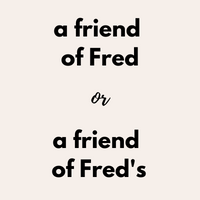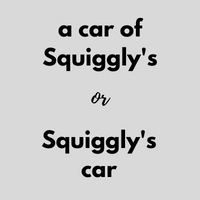
Now, Cathy has been wondering about the so-called double possessive and asks, “Which is correct—‘I am a friend of Fred’ or ‘I am a friend of Fred’s’?” She points out that it would sound normal to say, “He’s a friend of mine,” and “mine” is the possessive.
Cathy’s right, though you usually use only one possessive at a time. Many purists believe that double possessives should be relegated to informal and semiformal writing, if you use them at all. Nevertheless, double possessives have appeared in good writing for centuries, and most people will find themselves using them on occasion (1).
How to Create Possessives
You use possessives to indicate who owns what. If Squiggly owns a car, you say, “This is Squiggly’s car.” You use an apostrophe plus an “s” on the end of “Squiggly.” You can also form a possessive by using the word “of,” such as “The Crown Jewels of the United Kingdom.” (Of course, you could also say, “the United Kingdom’s Crown Jewels.”) These examples are just normal possessives. There’s nothing double about them. The confusion arises when you use both ways of making possessives at the same time, as in “a friend of Fred’s.” Here you have an apostrophe plus an “s” plus an “of.” Although such a double possessive is allowed, I personally prefer “Fred’s friend” over “a friend of Fred’s.” Why not just say, “He’s Fred’s friend”?
Incorrect Possessives
Nevertheless, to help us learn what’s right, let’s look at some possessives and double possessives that native speakers wouldn’t use. It definitely sounds odd to say, “a car of Squiggly.” On the other hand, you could say, “a car of Squiggly’s,” assuming he has lots of cars and you’re pointing out one of them. However, “a car of Squiggly’s” doesn’t sound as natural to me as “one of Squiggly’s cars.”
On the other hand, it’s perfectly normal to say, “the Crown Jewels of the United Kingdom” or “the United Kingdom’s Crown Jewels,” but it turns out that it’s ungrammatical to say, “the Crown Jewels of the United Kingdom’s.” Here’s a clear-cut rule that helps explain this: When you’re talking about inanimate objects—objects that aren’t alive, such as “the United Kingdom”—you can’t use a double possessive (2). According to The New Fowler’s Modern English Usage, for a double possessive to be legal, the object of the preposition “of” has to be “definite and human.” In other words, it’s fine to say, “a friend of my uncle’s” but not “a friend of the museum’s.” You have to say, “a friend of the museum.” However, according to this rule, it would be OK to say, “He’s a friend of a friend’s,” but we’ve all heard the common expression “a friend of a friend.” I guess double possessives don’t always work. That should make some sticklers happy.
Avoiding Double Possessives

Useful Double Possessives
There are, however, some cases when a double possessive is very useful to help clarify your meaning.
For example, if you attempt to avoid the double possessive and say something like “This is Marie’s portrait,” you end up with an ambiguous sentence that could mean you are looking at a portrait of Marie or a portrait that is owned by Marie. You can fix the problem by substituting one of two sentences depending on what you mean. If you mean Marie owns the portrait, then the double possessive makes it clear: “This is a portrait of Marie’s.” On the other hand, if it is a lovely rendering of Marie, “This is a portrait of Marie” will serve you well.
Another time when you might need to use a double possessive is if you want to use a possessive pronoun, such as “theirs,” “hers,” or “mine,” as Cathy noted in her initial question. In fact, it’s impossible to avoid using a double possessive in cases such as “She is a relative of his.” If you don’t like double possessives, you could reword such sentences by saying, “She is his relative,” “She is one of his relatives,” or, simply, “They are related.”
Double possessives might also be necessary if you’re using a “that,” “those,” “this,” or “these” in your possessive (3). For example, “the hat of Aardvark’s” sounds a bit odd to me, whereas “that hat of Aardvark’s” sounds a lot more natural.
In Summary
That question of Cathy’s was pretty tricky. Or, rather, I might prefer to say, “Cathy’s question was pretty tricky.” The better choices for her are “I am a friend of Fred,” or “I am Fred’s friend,” or even “Fred is my friend.”
The double possessive does have legitimate uses, but you might want to avoid the redundant possessive in formal writing and perhaps use only one possessive at a time if it sounds natural.
Administrative
This show was written by Bonnie Trenga, author of The Curious Case of the Misplaced Modifier, who blogs at Click this link.
- 1. Wilson, K.G. The Columbia Guide to Standard American English. Columbia University Press, 1993, Click this link (accessed August 16, 2008).
2. Burchfield, R. W, ed. The New Fowler’s Modern English Usage. Third edition. New York: Oxford, 1996, p. 227. - 3. Garner, B. Garner’s Modern American Usage. Oxford: Oxford University Press. 2003, pp. p. 624-25.




.png)